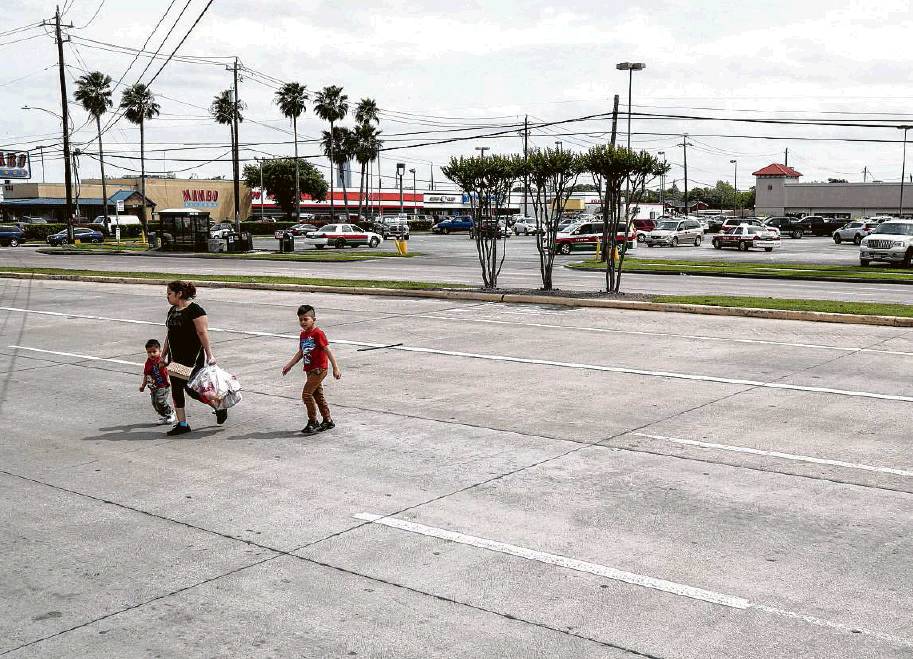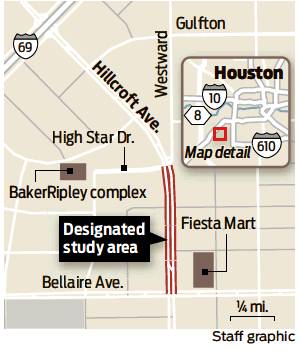GULFTON-AREA STUDY RETHINKS ROAD SAFETY
Team’s efforts could yield a template for rest of city to follow
By Dug Begley STAFF WRITER
One of Houston’s most difficult street safety riddles will be the starting point for a unique collaboration teaming Gulfton residents, students, nonprofit advocates and city officials in the hopes of making a mark along a street often marred by tragedy.
Houston leaders Wednesday announced the partnership with Together for Safer Roads, a roadway safety advocacy group poised to invest up to $150,000 to study and solicit ways to make Hillcroft Street safer, said David Braunstein, the group’s president.
They will work with Connect Community, a local nonprofit already working with Gulf-ton residents, and Houston-based engineering companies.
Efforts will focus on a 2,000-foot stretch of Hillcroft, from High Star to Bellaire, that is bustling most times of the day. The road segment is lined with commercial development, mostly small shops and restaurants, while apartment buildings dot the side streets. The road also is a major arterial for people heading to and from Interstate 69, north of the Gulfton area.
The the goal is to improve safety for all users of Hillcroft, whether they are in an automobile, on foot, bicycling, in a stroller or in wheelchair.
Though Houston has dozens of dangerous places along its streets, Hillcroft is one of the most intensely examined. It is the main street of a neighborhood where many do not own a car, as well as a critical thoroughfare.
Police responded to 332 crashes along the four-block segment from 2014 to 2018, according to statistics compiled by the Texas Department of Transportation. Among those incidents, two people — both pedestrians — died, including Maria Alvarez, 28, who was struck and killed last July by a driver as she pushed astroller across Hillcroft near Dashwood. Hillcroft is 10 lanes at Dashwood with a center median, but the city never has installed a signal or a crosswalk at the intersection.
“We are not looking to boil the ocean,” Braunstein said. “We are looking to put some visible changes on the ground later this year.”
Many of those ideas will come from the community, with assistance from advocates and planners.
“It is a neighborhood that knows there are unsafe streets but doesn’t know what is the next step,” said Anne Whitlock, founding director of Connect Community. “You have to fight against a narrative that already has been set for this neighborhood that this is the way it is. The important piece of this is we are activating all of those voices, and that will give you a better idea of what needs to be done.”
As part of the partnership, students at three area schools that participated in a science, technology, engineering and math program will identify and design their own solutions to local street safety issues. Whitlock said those ideas then will be presented to Houston Public Works.
The bulk of the money for any upgrades will come from the city. Houston Public Works has committed $500,000 from the city’s capital improvement program, specifically for safety projects along Hillcroft.
Spending could increase if an especially compelling project is identified that provides significant safety benefit, said Jeff Weatherford, deputy public works director for transportation and drainage operations.
Design conundrums
Those improvements could take many shapes, such as wider sidewalks, more noticeable and well-lit crosswalks or even new signals specifically for pedestrians. Wednesday at a celebration to kick off the partnership, Mayor Sylvester Turner said changes to Hill-croft could include “possible reduction of motor vehicle lanes.”
Braunstein said whatever changes are made, they will demonstrate what communities can do with cooperation.
“I think generally there is some negativity associated with these under-resourced communities,” Braunstein said, noting Gulfton’s challenges in terms of economics and community organizing, given its diverse population.
The group’s interest, he said, was spurred by a Houston Chronicle investigation last year that found the Houston region was the deadliest major metro area for roadway fatalities, where impaired driving and pedestrian safety has proved especially worrisome in many neglected areas.
“If you can achieve results in a community like Gulfton, that bodes well for doing it in other communities,” Braunstein said.
Together for Safer Roads brings with it large companies that sponsors the group, such as insurer AIG, trash and recycling contractor Republic Services and AT&T, which can connect business leaders in Houston to the efforts. Increasingly, some national companies are looking at community development as part of their philanthropic works, tackling issues such as roadway safety or education.
“This is not some faraway place,” said Cesar Vargas, vice president of legal and corporate affairs for Anheuser-Busch, which has a brewery and bottling plant in Houston. “We have employees and truck drivers and distributors and retailers and customers in these communities.”
Gulfton and surrounding neighborhoods pose some of the most difficult challenges in Houston for safety and public works officials. Once suburban enclaves, the neighborhoods have morphed into some of the most diverse in the region because of low housing prices.
The community’s design leaves many of those newcomers in a lurch. Shops and strip malls are set behind wide parking lots with multiple entrances and exits, with pedestrians plodding along narrow sidewalks against the major roadway. Often, people scramble across to the median outside of crosswalks, rather than travel the extra distance to a marked intersection.
For the Metropolitan Transit Authority, Gulfton remains the portion of its service area with the greatest demand for bus service. Meanwhile, pedestrians and cyclists navigate streets designed for cars that can leave residents facing wide intersections with fast, unimpeded right turns and signal timing that forces younger, elderly and disabled travelers to hustle, as hundreds of cars pass by.
“A lot of that traffic is not being generated in Gulfton itself; it is passing through Gulfton,” Braun-stein said.
For the city, that makes designing for both types of users a challenge, Weatherford said.
Methods such as speed bumps and islands that work on small streets will not work on Hillcroft, he said. Instead, it is a matter of the city finding strategies that serve all types of travelers.
Challenging car culture
Even that, Weatherford said, is a big change for Houston.
“Right now, it is all about moving cars,” he said of Hillcroft’s design. “Long-term, where we have to get with the entire system is it is about moving people: Cars, pedestrians, bicyclists and, hopefully, more people on transit.”
Taking that philosophy citywide, however will take years. Weatherford said capital improvement program funds are limited to a handful of projects annually, such as the Gulfton project and plans to redesign the intersection of Sunset and Main near Rice University and the light rail tracks where pedestrians and bicyclists have been killed both by automobiles and trains. Officials also pledged immediate repairs at Shepherd and 10th Street where two people were killed earlier this month.
“We can’t do undo 100 years of designing around the car overnight,” Weatherford said.
Repairing every problem spot in sprawling Houston will not come solely from safety repairs, but also gradual rebuilding of streets and redevelopment, officials said.
The Gulfton project, however, could give the city and advocacy groups a template of how teaming up resources can leverage more community participation.
“We know this is a long haul, but our kids keep getting hit,” Whitlock said. dug.begley@chron.com twitter.com/DugBegley

